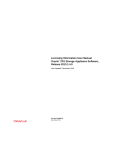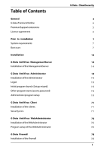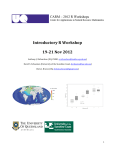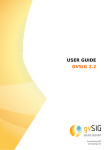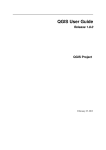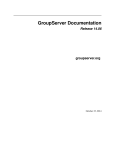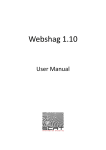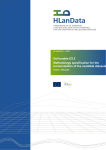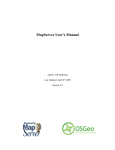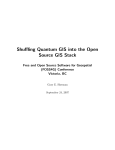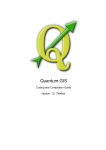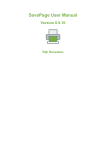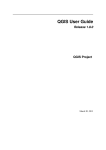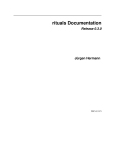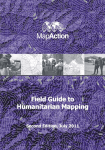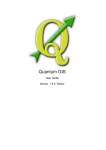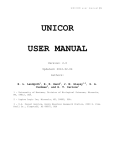Download GISBox Manual
Transcript
GISBox Manual
Citiviz Sàrl
October 18, 2013
Contents
1
2
3
4
Introduction . . . . . . . . . . . . . . . . .
Installed software . . . . . . . . . . . . . .
2.1
Main packages . . . . . . . . . . .
2.2
QGIS Plugins . . . . . . . . . . . .
2.3
Python libraries . . . . . . . . . .
Getting Started . . . . . . . . . . . . . . .
3.1
Minimum requirements . . . . . .
3.2
VirtualBoxTM installation . . . . .
3.3
Obtaining the GISBox appliance
3.4
Opening the appliance . . . . . . .
3.5
Importing the appliance . . . . . .
GISBox usage . . . . . . . . . . . . . . . .
4.1
Starting the appliance . . . . . . .
4.2
Login . . . . . . . . . . . . . . . .
4.3
The MATE desktop environnment
4.4
Installed software resources . . . .
4.5
Databases . . . . . . . . . . . . . .
.
.
.
.
.
.
.
.
.
.
.
.
.
.
.
.
.
.
.
.
.
.
.
.
.
.
.
.
.
.
.
.
.
.
.
.
.
.
.
.
.
.
.
.
.
.
.
.
.
.
.
.
.
.
.
.
.
.
.
.
.
.
.
.
.
.
.
.
.
.
.
.
.
.
.
.
.
.
.
.
.
.
.
.
.
.
.
.
.
.
.
.
.
.
.
.
.
.
.
.
.
.
.
.
.
.
.
.
.
.
.
.
.
.
.
.
.
.
.
.
.
.
.
.
.
.
.
.
.
.
.
.
.
.
.
.
.
.
.
.
.
.
.
.
.
.
.
.
.
.
.
.
.
.
.
.
.
.
.
.
.
.
.
.
.
.
.
.
.
.
.
.
.
.
.
.
.
.
.
.
.
.
.
.
.
.
.
3
3
4
4
5
5
5
5
6
6
6
8
8
9
11
11
12
A Open the appliance manually
13
B Shared Folders
15
C Change keyboard layout
17
D Change password
19
E Licence Agreements
21
1
Licence Agreement ’GISBox’ . . . . . . . . . . . . . . . . . . 21
2
GNU General Public License . . . . . . . . . . . . . . . . . . 23
1
List of Figures
1
2
3
4
5
6
7
8
9
GISBox appliance . . . . . . . . .
Importing appliance dialog . . . .
"accept licence" dialog . . . . . . .
"importing appliance" progress bar
GISBox appliance imported . . .
Starting the appliance . . . . . . .
GISBox booting . . . . . . . . . .
GISBox login screen . . . . . . . .
GISBox desktop . . . . . . . . . .
.
.
.
.
.
.
.
.
.
.
.
.
.
.
.
.
.
.
.
.
.
.
.
.
.
.
.
.
.
.
.
.
.
.
.
.
.
.
.
.
.
.
.
.
.
.
.
.
.
.
.
.
.
.
.
.
.
.
.
.
.
.
.
.
.
.
.
.
.
.
.
.
.
.
.
.
.
.
.
.
.
.
.
.
.
.
.
.
.
.
.
.
.
.
.
.
.
.
.
.
.
.
.
.
.
.
.
.
.
.
.
.
.
.
.
.
.
.
.
.
.
.
.
.
.
.
.
.
.
.
.
.
.
.
.
3
6
7
7
8
8
9
10
10
A.1 VirtualBoxTM main window and opening the import tool dialog 14
A.2 Importing tool dialog . . . . . . . . . . . . . . . . . . . . . . . 14
A.3 Selecting appliance dialog . . . . . . . . . . . . . . . . . . . . 14
B.1
B.2
B.3
B.4
GISBox SharedFolders icons. . . . . . . . . . . . . .
VirtualBoxTM Shared Folder icon . . . . . . . . . . .
Adding a VirtualBoxTM Shared Folder . . . . . . . .
Accessing the "shared" folder from the "Places" menu
.
.
.
.
15
15
16
16
C.1 Accessing the keyboard preferences. . . . . . . . . . . . . . .
C.2 Keyboard layouts preferences. . . . . . . . . . . . . . . . . . .
17
18
D.1
D.2
D.3
D.4
19
19
20
20
Accessing the "About Me" preference dialog . . . .
"About Me" preference dialog . . . . . . . . . . . .
"Change password" dialog . . . . . . . . . . . . . .
Opening a terminal and passwd command example
2
.
.
.
.
.
.
.
.
.
.
.
.
.
.
.
.
.
.
.
.
.
.
.
.
.
.
.
.
.
.
.
.
.
.
.
.
.
.
.
.
Contents
1
Introduction
Citiviz’s GISBox is a fully installed, pre-configured and tuned system for
Geographical Information System (GIS), data-mining, statistical analysis
work and programming. It is based on the Sabayon Linux distribution
featuring the MATE (lightweight) desktop environnment.
Figure 1: GISBox appliance
2
Installed software
The complete list of packages installed on the GISBox can be found at
http://citiviz.com/gisbox/packages/1.0.
3
2.1
Main packages
package
version
description
licence
Geographical Information Systems software
Postgis
2.0.3
Geographic Objects for PostgreSQL
Grass
6.4.1
OpenSource GIS
QGIS
1.8.0
OpenSource GIS
MapServer
6.0.1
Geographic map server
MapProxy
1.5.0
WMS tiles caching proxy
Statistical and numerical analysis
QtOctave
0.10.1 Graphical frontend to Octave
Octave
3.6.4
Matlab-like language
RStudio
0.97.336 Graphical frontend to R
R
3.0.1
Statistical and graphics tool
WEKA
3.6.6
A Java data mining package
Office & productivity
LaTeXila
2.6.2
Integrated LaTeX environment
LibreOffice
4.0.2.2 full office suite productivity
Aurora
20.0.1 Unbranded Firefox web browser
General programming
gvim
7.3.905 graphical vim text editor
xemacs
21.5.31 graphical emacs text editor
pluma
1.6.0
MATE graphical text editor
gcc
4.7.3
C/C++, Fortran, ObjC, . . .
perl
5.12.4 Perl programming language
python
2.6.8/2.7.3 Python programming language
Spyder
2.1.13 matlab-like Python IDE
QT Designer
4.8.4
QT GUI Mockup application
QT Assistant
4.8.4
QT Online documentation
QT Linguist
4.8.4
QT Internationalization tool
Databases
PostgreSQL
9.1.9
PostgreSQL server
MySQL
5.5.30 MySQL server
sqlite
3.7.15 single-file SQL database
2.2
GPL-2
GPL-2
GPL-2
MIT
Apache-2.0
GPL-2
GPL-3
AGPL-3
GPL-3
GPL-2
GPL-3
LGPL-3
GPL-2
vim
GPL-3
GPL-2
GPL-3
GPL-3
PSF-2
MIT
GPL-3
GPL-3
GPL-3
GPL-2
GPL-2
public-domain
QGIS Plugins
plugin
Coordinate Capture
GPS Tools
GRASS
GdalTools
Georeferencer GDAL
Home range estimation w/ R
Load Postgis Raster to QGIS
MapServer Export
OpenLayers Plugin
Plugin Installer
SEXTANTE
fTools
manageR
mmqgis
version
n/a
n/a
n/a
1.2.29
n/a
2.1.8
0.5.4
0.4.3
1.1.0
1.2.1
1.0.9
0.6.2
1.1
2012.12.07
description
Capture coordinates in different CRS
Tools for importing GPS data
GRASS layer
Integrates GDAL tools into QGIS
Georeferencing raster using GDAL
Kernel NNCH and MCP with R
Load Postgis raster tables
QGIS project to MapServer map file
OpenStreetMap, Google and Bing layers
Manage QGIS python plugins
Geoprocessing Platform for QGIS
Vector data analysis and management
Interface to R
QGIS vector layer operation plugins
4
2.3
Python libraries
library
networkx
gdal
mapscript
shapely
pyshp
geoalchemy
sqlalchemy
psycopg
numpy
wxpython
pycurl
decorator
virtualenv
3
version
1.7
1.9.2
6.0.1
1.2.17
1.1.4
0.7.1
0.8.0
2.5
1.7.1
2.8.12.1
7.19.0
3.4.0
1.9.1
description
Graph and network library
Raster geospatial data formats
Python bindings for mapserver
Work with geometric objects
Read and write shapefile
SQLAlchemy extension for spatial databases
Python SQL drivers
SQLAlchemy driver for PostgreSQL
Fast array processing library
Cross-platform GUI toolkit
Python cURL bindings
Simplified Python decorators
Virtual Python environnment builder
Getting Started
3.1
Minimum requirements
• Intel or AMD 64bit CPU;
• Hardware virtualization extensions enabled in the BIOS (VT-x for
Intel, AMD-V for AMD)1 ;
• at least 2GB of RAM;
• at least 30GB or free disk space2 ;
• a 64bit operating system.
Please notice that the appliance settings defaults are set to 2 CPUs and
2GB of RAM. If your system has 2 or less CPUs, set the number of assigned
CPUs to 1; if you have less than 4GB of RAM, assign at most half of the
RAM to the appliance. You can change these settings before importing the
appliance into VirtualBoxTM (Section 3.5).
3.2
VirtualBoxTM installation
A very good page on the correct installation and configuration of VirtualBoxTM
can be found at ENAC-IT site (french only):
http://enacit.epfl.ch/virtualisation/virtualbox.shtml3 .
1
Usually these extensions are disabled by default on most systems. To enable the
virtualization extensions, please refer to your computer’s manual.
2
A freshly installed appliance will take about 9GB of disk space. Without using
VirtualBoxTM snapshots it can take up to 30GB, if you add data to the appliance. If
you use snapshots, it can take more space.
3
"VirtualBox Extension Pack" is not needed by the GISBox appliance. However, it
does not hurt to install it: it will be useful if you want to plug some USB 2.0 devices
directly to the GISBox. Refer to Appendix B for a simpler way to transfer data between
your system and the GISBox
5
3.3
Obtaining the GISBox appliance
The GISBox virtual machine appliance can be downloaded from:
• Citiviz: http://citiviz.com/gisbox/, or
• EPFL’s ENACSoft: http://gisbox.epfl.ch - use this only if you
are at EPFL
3.4
Opening the appliance
On most operating systems, opening the GISBox-1.0.ova file will automatically launch VirtualBoxTM and start the importing process. You should see
a dialog like the one in Fig. 2.
If your operating system is unable to automatically open the import
dialog, please refer to Appendix A.
Figure 2: Importing appliance dialog
3.5
Importing the appliance
Now you should be looking at a dialog resembling the one in Fig. 2, whether
you have opened the appliance automatically or manually. You are now
ready to review the details and start the actual importing process.
Review the details and configuration of the appliance
Within the import dialog you can change the name of the appliance, the
number of CPUs and the RAM assigned to the appliance. The default
settings (2 CPUs and 2048MB or RAM) are more than enough. When you
are satisfied with the settings, you can click the Import button.
6
Accept the licences
The GISBox appliance is delivered under different licences: The GISBox
is a collection of free software and is released under the GNU General Public
License (GPLv3), with the exception of Citiviz trademarks, logo and additional software. See Appendix E for the licence agreements and the full text
of the GPLv3.
A dialog asking you to agree with these conditions will appear (Fig. 3).
By clicking the Agree button you accept those conditions and will be able
to continue.
Figure 3: "accept licence" dialog
Importing process
The importing process will take only a few minutes, you will see a progress
bar showing how much time it will take (Fig.4).
Figure 4: "importing appliance" progress bar
Appliance is ready
Once the importing process finished, you should see the GISBox appliance
in the VirtualBoxTM main window, like in Fig. 5.
7
Figure 5: GISBox appliance imported
4
4.1
GISBox usage
Starting the appliance
From the VirtualBoxTM main window, select the GISBox appliance and
click the Start button, as in Fig. 6.
Figure 6: Starting the appliance
A new window showing the virtual machine monitor will appear. Let
it boot (Fig. 7). At the end of the boot process the login screen should
appear, as in Fig. 8.
8
Figure 7: GISBox booting
4.2
Login
These are the credentials to log in:
• login: user
• password: password
In other words, type user, hit Enter, type password and hit Enter again.
The login dialog will disappear while the GISBox session is starting. A
clean GISBox desktop looks like the one in Fig. 9.
It is recommended to change the user password, a short "howto" can be
found in Appendix D.
9
Figure 8: GISBox login screen
Figure 9: GISBox desktop
10
4.3
The MATE desktop environnment
This part of the documentation will be improved in the future. For the
moment, please refer to the project’s website and online documentation.
http://mate-desktop.org/.
If you want to change the keyboard mapping, there is a short "howto"
in Appendix C.
4.4
Installed software resources
This part of the documentation will be improved in the future. For the moment, please refer to the projects’ respective websites and online documentation.
GIS software
QGIS
http://www.qgis.org/.
Grass
http://grass.osgeo.org/.
MapServer
http://mapserver.org/.
MapProxy http://mapproxy.org/.
Statistical and numerical analysis
QtOctave
RStudio
WEKA
http://developer.berlios.de/projects/qtoctave/.
http://www.rstudio.org/.
http://www.cs.waikato.ac.nz/~ml/weka/.
Office and productivity
LaTeXila
LibreOffice
https://projects.gnome.org/latexila/.
http://libreoffice.org/.
Programming
Spyder http://spyder-ide.blogspot.com/.
gvim http://vim.org/.
xemacs http://www.xemacs.org/.
11
QT Designer
4.5
http://qt.digia.com.
Databases
PostgreSQL
PostGIS
http://www.postgresql.org/.
http://postgis.net/.
MySQL http://www.mysql.com/.
sqlite
http://www.sqlite.org/.
12
Appendix A
Open the appliance manually
1. Open VirtualBoxTM ;
2. in VirtualBoxTM , open the "importing tool" (Fig. A.1):
File > Import Appliance...;
3. the "importing tool" dialog (Fig. A.2) will show;
4. click the Open Appliance... button. A "select appliance" dialog
(Fig. A.3) will show;
5. within the "select appliance" dialog, navigate to the appliance file and
open it;
6. you are back to the "importing tool" dialog (Fig. A.2), click the
Next > button;
7. you should now see the "Import appliance" dialog (Fig. 2);
8. Go back to Section 3.5 and follow instructions to complete the import
process.
13
Figure A.1: VirtualBoxTM main window and opening the import tool dialog
Figure A.2: Importing tool dialog
Figure A.3: Selecting appliance dialog
14
Appendix B
Shared Folders
The most straightforward way to exchange data between the host (your
computer) and the guest (the GISBox) is by using VirtualBoxTM ’s Shared
Folder feature. GISBox comes with two useful icons on the top bar (Fig.
B.1), one to make all the configured shared folders available inside the
guest, the other to release them (SharedFolders mounter on the left, and
SharedFolders unmounter on the right).
Figure B.1: GISBox SharedFolders icons.
All you need to do is setup some shared folders in VirtualBoxTM (Figures
B.2 and B.3) and click the SharedFolders mounter icon: you will find all
your host folders inside the /home/user/shared/ directory (Fig. B.4).
Figure B.2: VirtualBoxTM Shared Folder icon
15
Figure B.3: Adding a VirtualBoxTM Shared Folder
Figure B.4: Accessing the "shared" folder from the "Places" menu
16
Appendix C
Change keyboard layout
Figure C.1: Accessing the keyboard preferences.
17
Figure C.2: Keyboard layouts preferences.
18
Appendix D
Change password
To change the user password you can use the graphical tool or the command
line.
Change password graphically To change the user password graphically,
you should access the "About Me" preference dialog. It can be found in the
System -> Preferences menu.
Figure D.1: Accessing the "About Me" preference dialog
The "About Me" preference dialog looks like Fig. D.2. It has a button
labeled Change Password..., click it and the change password dialog (Fig.
D.3) will appear.
Figure D.2: "About Me" preference dialog
As explained in the "Change password" dialog itself, you should first Authenticate (by entering the current password and click the Authenticate
19
button), then enter a new password twice and click the Change password
button on the bottom left.
Figure D.3: "Change password" dialog
Change password using the command line Open a Terminal and type
passwd (Fig. D.4).
Figure D.4: Opening a terminal and passwd command example
Like the graphical way, you should first enter the current password and
then the new password twice. Note that you should type the passwords
"blindly", since the cursors will not move as you type.
20
Appendix E
Licence Agreements
1
Licence Agreement ’GISBox’
IMPORTANT INFORMATION. By downloading, installing, or using
the virtual appliance GISBox (the "Product"), the Individual or the Legal
Entity ("You") will have accepted the terms and agree to be bound by the
terms of this Licence Agreement (the "Agreement"). Installing the Product
establishes a binding agreement between You as the person licensing the software, either on behalf of yourself or any third party entity (the "Licencee"),
Citiviz Sàrl ("Citiviz", "We", "Us") and the respective copyright holders and
contributors. If You do not agree to the terms of this Agreement, You must
not download, install, or use the Product, and must delete the unused.
GENERAL DISCLAIMER. This Product is free software: you can redistribute it and/or modify it under the terms of the GNU General Public
License as published by the Free Software Foundation, either version 3 of
the License, or (at your option) any later version. The Product as a whole
is distributed under the GNU General Public Licence version 3 (the "GNU
GPLv3"), but is subordinated to the Licence Agreements of the constituent
software packages (the "Software Packages"). These Software Packages may
have Licence Agreement that are more or less restrictive than the GNU
GPLv3. You should ensure that You understand and agree with the terms of
these Software Packages Licence Agreements. We have prepared a package
and licence list for your convenience. We have relied on Software Packages
meta data, licence files, and community contributions in creating this list,
and We make this list available on an "AS IS" basis. The list is updated
often, but we make no representation or warranty as to the accuracy or
completeness of it, and We expressly disclaim any implied warranties to the
fullest extent permissible at law. We accept no liability for any damage or
loss arising from your use or reliance on the list. The list is available here:
<http://citiviz.com/gisbox/packages>. You are allowed to freely dis-
21
tribute, redistribute, modify, duplicate and pass around the Product along
with this Product Agreement and the GNU GPLv3 General Licence Agreement. You should have received a copy of the GNU General Public Licence
along with this Agreement. If not, see <http://www.gnu.org/licenses/>.
NO WARRANTY. The contents of the Product are provided under this
Agreement by Citiviz and the respective copyright holders and contributors
"AS IS" and any express or implied warranties, including, but not limited
to, the implied warranties of the merchantability and fitness for a particular
purpose are disclaimed. Citiviz does not warrant the Product in any way,
including but not limited to performance or features of the Product. In no
event shall Citiviz or any Software Packages copyright owners or contributors be liable for any direct, indirect, incidental, special, exemplary, punitive,
consequential or other damages (including, but not limited to, procurement
of substitute goods or services; loss of use, data, or profits; or business interruption) however caused and on any theory of liability, whether in contract,
strict liability, or tort (including negligence or otherwise) arising in any way
out of the use of this Products and Software Packages, even if advised of
the possibility of such damage. This includes, without limitation, any damage to computer systems, hardware or software, or any other performance
errors, bugs, viruses, failures or refects that result from, or are associated
with the use of this Product to the fullest extent permitted at law.
TRADEMARKS. Any trademarks and logos used and displayed by the
Product are the property of their owners, whether Citiviz or third parties.
Citiviz owns a number of trademarks, including "Citiviz" and "URBAN INTELLIGENCE", and use of these trademarks and logos are subject to compliance with Citiviz’ trademark policy and rights. The Citiviz’ trademark
policy and rights is available here: <http://citiviz.com/info/tc>.
REDISTRIBUTION. You can redistribute the Product under the terms
of the GNU GPLv3 General Licence Agreement. "For both users’ and authors’ sake, the GNU GPLv3 requires that modified versions be marked as
changed, so that their problems will not be attributed erroneously to authors of previous versions" (from GNU GPLv3). You must, for any redistribution of modified versions of the Product, remove or replace the "GISBox"
Product name, Trademarks and Logos from Citiviz. If You are going to
associate modified versions of the Product with "GISBox" Product name,
Citiviz Trademarks or Logos, the Product must be approved, certified or
provided by Citiviz and you will require a licence agreement from Citiviz,
for which you may be required fees.
22
GOVERNING LAWS. The parties agree this Agreement will be governed by the laws of the Canton of Vaud and of Switzerland, without regard
to its conflicts of laws principles, shall govern all matters relating to access
to, or use of, the Product. The parties specifically disclaim the U.N. Convention on Contracts for the International Sale of Goods. The parties agree
that any action brought by either party to enforce or interpret any provision of the Agreement shall be brought exclusively in an appropriate court
in Canton of Vaud or in Switzerland Court. The parties hereby irrevocably
consent to such jurusdiction and waive any objection to such venue.
LOCAL LAWS. If you are located outside of Switzerland, you further
agree and are fully responsible for compliance with any and all applicable
local laws regarding how You are using the Software. If the use of the
Product should brake any local laws, you must not download, install, or use
the Product, and must delete the unused. Citiviz makes no representation
that the Product is appropriate or available for use in other locations, and
for using the Product from territories where it is illegal or prohibited.
2
GNU General Public License
c 2007 Free Software Foundation, Inc. http://fsf.org/
Copyright Everyone is permitted to copy and distribute verbatim copies of this
license document, but changing it is not allowed.
23
Preamble
The GNU General Public License is a free, copyleft license for software and
other kinds of works.
The licenses for most software and other practical works are designed to
take away your freedom to share and change the works. By contrast, the
GNU General Public License is intended to guarantee your freedom to share
and change all versions of a program–to make sure it remains free software
for all its users. We, the Free Software Foundation, use the GNU General
Public License for most of our software; it applies also to any other work
released this way by its authors. You can apply it to your programs, too.
When we speak of free software, we are referring to freedom, not price.
Our General Public Licenses are designed to make sure that you have the
freedom to distribute copies of free software (and charge for them if you
wish), that you receive source code or can get it if you want it, that you can
change the software or use pieces of it in new free programs, and that you
know you can do these things.
To protect your rights, we need to prevent others from denying you these
rights or asking you to surrender the rights. Therefore, you have certain
responsibilities if you distribute copies of the software, or if you modify it:
responsibilities to respect the freedom of others.
For example, if you distribute copies of such a program, whether gratis
or for a fee, you must pass on to the recipients the same freedoms that you
received. You must make sure that they, too, receive or can get the source
code. And you must show them these terms so they know their rights.
Developers that use the GNU GPL protect your rights with two steps:
(1) assert copyright on the software, and (2) offer you this License giving
you legal permission to copy, distribute and/or modify it.
For the developers’ and authors’ protection, the GPL clearly explains
that there is no warranty for this free software. For both users’ and authors’
sake, the GPL requires that modified versions be marked as changed, so
that their problems will not be attributed erroneously to authors of previous
versions.
Some devices are designed to deny users access to install or run modified
versions of the software inside them, although the manufacturer can do so.
This is fundamentally incompatible with the aim of protecting users’ freedom
to change the software. The systematic pattern of such abuse occurs in
the area of products for individuals to use, which is precisely where it is
most unacceptable. Therefore, we have designed this version of the GPL to
prohibit the practice for those products. If such problems arise substantially
in other domains, we stand ready to extend this provision to those domains
in future versions of the GPL, as needed to protect the freedom of users.
Finally, every program is threatened constantly by software patents.
States should not allow patents to restrict development and use of software on general-purpose computers, but in those that do, we wish to avoid
the special danger that patents applied to a free program could make it effectively proprietary. To prevent this, the GPL assures that patents cannot
be used to render the program non-free.
The precise terms and conditions for copying, distribution and modification follow.
2
Terms and Conditions
0. Definitions.
“This License” refers to version 3 of the GNU General Public License.
“Copyright” also means copyright-like laws that apply to other kinds
of works, such as semiconductor masks.
“The Program” refers to any copyrightable work licensed under this
License. Each licensee is addressed as “you”. “Licensees” and “recipients” may be individuals or organizations.
To “modify” a work means to copy from or adapt all or part of the work
in a fashion requiring copyright permission, other than the making of
an exact copy. The resulting work is called a “modified version” of the
earlier work or a work “based on” the earlier work.
A “covered work” means either the unmodified Program or a work
based on the Program.
To “propagate” a work means to do anything with it that, without permission, would make you directly or secondarily liable for infringement
under applicable copyright law, except executing it on a computer or
modifying a private copy. Propagation includes copying, distribution
(with or without modification), making available to the public, and in
some countries other activities as well.
To “convey” a work means any kind of propagation that enables other
parties to make or receive copies. Mere interaction with a user through
a computer network, with no transfer of a copy, is not conveying.
An interactive user interface displays “Appropriate Legal Notices” to
the extent that it includes a convenient and prominently visible feature that (1) displays an appropriate copyright notice, and (2) tells the
user that there is no warranty for the work (except to the extent that
warranties are provided), that licensees may convey the work under
this License, and how to view a copy of this License. If the interface presents a list of user commands or options, such as a menu, a
prominent item in the list meets this criterion.
1. Source Code.
The “source code” for a work means the preferred form of the work
for making modifications to it. “Object code” means any non-source
form of a work.
A “Standard Interface” means an interface that either is an official
standard defined by a recognized standards body, or, in the case of
interfaces specified for a particular programming language, one that is
widely used among developers working in that language.
1
The “System Libraries” of an executable work include anything, other
than the work as a whole, that (a) is included in the normal form of
packaging a Major Component, but which is not part of that Major
Component, and (b) serves only to enable use of the work with that
Major Component, or to implement a Standard Interface for which an
implementation is available to the public in source code form. A “Major Component”, in this context, means a major essential component
(kernel, window system, and so on) of the specific operating system (if
any) on which the executable work runs, or a compiler used to produce
the work, or an object code interpreter used to run it.
The “Corresponding Source” for a work in object code form means
all the source code needed to generate, install, and (for an executable
work) run the object code and to modify the work, including scripts
to control those activities. However, it does not include the work’s
System Libraries, or general-purpose tools or generally available free
programs which are used unmodified in performing those activities
but which are not part of the work. For example, Corresponding
Source includes interface definition files associated with source files for
the work, and the source code for shared libraries and dynamically
linked subprograms that the work is specifically designed to require,
such as by intimate data communication or control flow between those
subprograms and other parts of the work.
The Corresponding Source need not include anything that users can regenerate automatically from other parts of the Corresponding Source.
The Corresponding Source for a work in source code form is that same
work.
2. Basic Permissions.
All rights granted under this License are granted for the term of copyright on the Program, and are irrevocable provided the stated conditions are met. This License explicitly affirms your unlimited permission to run the unmodified Program. The output from running a
covered work is covered by this License only if the output, given its
content, constitutes a covered work. This License acknowledges your
rights of fair use or other equivalent, as provided by copyright law.
You may make, run and propagate covered works that you do not
convey, without conditions so long as your license otherwise remains
in force. You may convey covered works to others for the sole purpose
of having them make modifications exclusively for you, or provide you
with facilities for running those works, provided that you comply with
the terms of this License in conveying all material for which you do not
control copyright. Those thus making or running the covered works
for you must do so exclusively on your behalf, under your direction
2
and control, on terms that prohibit them from making any copies of
your copyrighted material outside their relationship with you.
Conveying under any other circumstances is permitted solely under
the conditions stated below. Sublicensing is not allowed; section 10
makes it unnecessary.
3. Protecting Users’ Legal Rights From Anti-Circumvention Law.
No covered work shall be deemed part of an effective technological
measure under any applicable law fulfilling obligations under article
11 of the WIPO copyright treaty adopted on 20 December 1996, or
similar laws prohibiting or restricting circumvention of such measures.
When you convey a covered work, you waive any legal power to forbid
circumvention of technological measures to the extent such circumvention is effected by exercising rights under this License with respect
to the covered work, and you disclaim any intention to limit operation or modification of the work as a means of enforcing, against the
work’s users, your or third parties’ legal rights to forbid circumvention
of technological measures.
4. Conveying Verbatim Copies.
You may convey verbatim copies of the Program’s source code as you
receive it, in any medium, provided that you conspicuously and appropriately publish on each copy an appropriate copyright notice; keep intact all notices stating that this License and any non-permissive terms
added in accord with section 7 apply to the code; keep intact all notices of the absence of any warranty; and give all recipients a copy of
this License along with the Program.
You may charge any price or no price for each copy that you convey,
and you may offer support or warranty protection for a fee.
5. Conveying Modified Source Versions.
You may convey a work based on the Program, or the modifications
to produce it from the Program, in the form of source code under the
terms of section 4, provided that you also meet all of these conditions:
(a) The work must carry prominent notices stating that you modified
it, and giving a relevant date.
(b) The work must carry prominent notices stating that it is released
under this License and any conditions added under section 7.
This requirement modifies the requirement in section 4 to “keep
intact all notices”.
(c) You must license the entire work, as a whole, under this License
to anyone who comes into possession of a copy. This License will
3
therefore apply, along with any applicable section 7 additional
terms, to the whole of the work, and all its parts, regardless
of how they are packaged. This License gives no permission to
license the work in any other way, but it does not invalidate such
permission if you have separately received it.
(d) If the work has interactive user interfaces, each must display Appropriate Legal Notices; however, if the Program has interactive
interfaces that do not display Appropriate Legal Notices, your
work need not make them do so.
A compilation of a covered work with other separate and independent
works, which are not by their nature extensions of the covered work,
and which are not combined with it such as to form a larger program,
in or on a volume of a storage or distribution medium, is called an
“aggregate” if the compilation and its resulting copyright are not used
to limit the access or legal rights of the compilation’s users beyond
what the individual works permit. Inclusion of a covered work in an
aggregate does not cause this License to apply to the other parts of
the aggregate.
6. Conveying Non-Source Forms.
You may convey a covered work in object code form under the terms of
sections 4 and 5, provided that you also convey the machine-readable
Corresponding Source under the terms of this License, in one of these
ways:
(a) Convey the object code in, or embodied in, a physical product
(including a physical distribution medium), accompanied by the
Corresponding Source fixed on a durable physical medium customarily used for software interchange.
(b) Convey the object code in, or embodied in, a physical product
(including a physical distribution medium), accompanied by a
written offer, valid for at least three years and valid for as long as
you offer spare parts or customer support for that product model,
to give anyone who possesses the object code either (1) a copy
of the Corresponding Source for all the software in the product
that is covered by this License, on a durable physical medium
customarily used for software interchange, for a price no more
than your reasonable cost of physically performing this conveying
of source, or (2) access to copy the Corresponding Source from a
network server at no charge.
(c) Convey individual copies of the object code with a copy of the
written offer to provide the Corresponding Source. This alternative is allowed only occasionally and noncommercially, and only
4
if you received the object code with such an offer, in accord with
subsection 6b.
(d) Convey the object code by offering access from a designated place
(gratis or for a charge), and offer equivalent access to the Corresponding Source in the same way through the same place at
no further charge. You need not require recipients to copy the
Corresponding Source along with the object code. If the place
to copy the object code is a network server, the Corresponding
Source may be on a different server (operated by you or a third
party) that supports equivalent copying facilities, provided you
maintain clear directions next to the object code saying where to
find the Corresponding Source. Regardless of what server hosts
the Corresponding Source, you remain obligated to ensure that
it is available for as long as needed to satisfy these requirements.
(e) Convey the object code using peer-to-peer transmission, provided
you inform other peers where the object code and Corresponding
Source of the work are being offered to the general public at no
charge under subsection 6d.
A separable portion of the object code, whose source code is excluded
from the Corresponding Source as a System Library, need not be included in conveying the object code work.
A “User Product” is either (1) a “consumer product”, which means
any tangible personal property which is normally used for personal,
family, or household purposes, or (2) anything designed or sold for
incorporation into a dwelling. In determining whether a product is a
consumer product, doubtful cases shall be resolved in favor of coverage.
For a particular product received by a particular user, “normally used”
refers to a typical or common use of that class of product, regardless of
the status of the particular user or of the way in which the particular
user actually uses, or expects or is expected to use, the product. A
product is a consumer product regardless of whether the product has
substantial commercial, industrial or non-consumer uses, unless such
uses represent the only significant mode of use of the product.
“Installation Information” for a User Product means any methods,
procedures, authorization keys, or other information required to install
and execute modified versions of a covered work in that User Product
from a modified version of its Corresponding Source. The information
must suffice to ensure that the continued functioning of the modified
object code is in no case prevented or interfered with solely because
modification has been made.
If you convey an object code work under this section in, or with, or
specifically for use in, a User Product, and the conveying occurs as
5
part of a transaction in which the right of possession and use of the
User Product is transferred to the recipient in perpetuity or for a fixed
term (regardless of how the transaction is characterized), the Corresponding Source conveyed under this section must be accompanied by
the Installation Information. But this requirement does not apply if
neither you nor any third party retains the ability to install modified object code on the User Product (for example, the work has been
installed in ROM).
The requirement to provide Installation Information does not include
a requirement to continue to provide support service, warranty, or updates for a work that has been modified or installed by the recipient,
or for the User Product in which it has been modified or installed.
Access to a network may be denied when the modification itself materially and adversely affects the operation of the network or violates
the rules and protocols for communication across the network.
Corresponding Source conveyed, and Installation Information provided,
in accord with this section must be in a format that is publicly documented (and with an implementation available to the public in source
code form), and must require no special password or key for unpacking,
reading or copying.
7. Additional Terms.
“Additional permissions” are terms that supplement the terms of this
License by making exceptions from one or more of its conditions. Additional permissions that are applicable to the entire Program shall
be treated as though they were included in this License, to the extent
that they are valid under applicable law. If additional permissions
apply only to part of the Program, that part may be used separately
under those permissions, but the entire Program remains governed by
this License without regard to the additional permissions.
When you convey a copy of a covered work, you may at your option
remove any additional permissions from that copy, or from any part
of it. (Additional permissions may be written to require their own
removal in certain cases when you modify the work.) You may place
additional permissions on material, added by you to a covered work,
for which you have or can give appropriate copyright permission.
Notwithstanding any other provision of this License, for material you
add to a covered work, you may (if authorized by the copyright holders
of that material) supplement the terms of this License with terms:
(a) Disclaiming warranty or limiting liability differently from the
terms of sections 15 and 16 of this License; or
6
(b) Requiring preservation of specified reasonable legal notices or author attributions in that material or in the Appropriate Legal
Notices displayed by works containing it; or
(c) Prohibiting misrepresentation of the origin of that material, or
requiring that modified versions of such material be marked in
reasonable ways as different from the original version; or
(d) Limiting the use for publicity purposes of names of licensors or
authors of the material; or
(e) Declining to grant rights under trademark law for use of some
trade names, trademarks, or service marks; or
(f) Requiring indemnification of licensors and authors of that material by anyone who conveys the material (or modified versions of
it) with contractual assumptions of liability to the recipient, for
any liability that these contractual assumptions directly impose
on those licensors and authors.
All other non-permissive additional terms are considered “further restrictions” within the meaning of section 10. If the Program as you
received it, or any part of it, contains a notice stating that it is governed by this License along with a term that is a further restriction,
you may remove that term. If a license document contains a further
restriction but permits relicensing or conveying under this License, you
may add to a covered work material governed by the terms of that license document, provided that the further restriction does not survive
such relicensing or conveying.
If you add terms to a covered work in accord with this section, you
must place, in the relevant source files, a statement of the additional
terms that apply to those files, or a notice indicating where to find the
applicable terms.
Additional terms, permissive or non-permissive, may be stated in the
form of a separately written license, or stated as exceptions; the above
requirements apply either way.
8. Termination.
You may not propagate or modify a covered work except as expressly
provided under this License. Any attempt otherwise to propagate or
modify it is void, and will automatically terminate your rights under
this License (including any patent licenses granted under the third
paragraph of section 11).
However, if you cease all violation of this License, then your license
from a particular copyright holder is reinstated (a) provisionally, unless
and until the copyright holder explicitly and finally terminates your
7
license, and (b) permanently, if the copyright holder fails to notify you
of the violation by some reasonable means prior to 60 days after the
cessation.
Moreover, your license from a particular copyright holder is reinstated
permanently if the copyright holder notifies you of the violation by
some reasonable means, this is the first time you have received notice
of violation of this License (for any work) from that copyright holder,
and you cure the violation prior to 30 days after your receipt of the
notice.
Termination of your rights under this section does not terminate the
licenses of parties who have received copies or rights from you under
this License. If your rights have been terminated and not permanently
reinstated, you do not qualify to receive new licenses for the same
material under section 10.
9. Acceptance Not Required for Having Copies.
You are not required to accept this License in order to receive or
run a copy of the Program. Ancillary propagation of a covered work
occurring solely as a consequence of using peer-to-peer transmission to
receive a copy likewise does not require acceptance. However, nothing
other than this License grants you permission to propagate or modify
any covered work. These actions infringe copyright if you do not accept
this License. Therefore, by modifying or propagating a covered work,
you indicate your acceptance of this License to do so.
10. Automatic Licensing of Downstream Recipients.
Each time you convey a covered work, the recipient automatically
receives a license from the original licensors, to run, modify and propagate that work, subject to this License. You are not responsible for
enforcing compliance by third parties with this License.
An “entity transaction” is a transaction transferring control of an organization, or substantially all assets of one, or subdividing an organization, or merging organizations. If propagation of a covered work
results from an entity transaction, each party to that transaction who
receives a copy of the work also receives whatever licenses to the work
the party’s predecessor in interest had or could give under the previous
paragraph, plus a right to possession of the Corresponding Source of
the work from the predecessor in interest, if the predecessor has it or
can get it with reasonable efforts.
You may not impose any further restrictions on the exercise of the
rights granted or affirmed under this License. For example, you may
not impose a license fee, royalty, or other charge for exercise of rights
8
granted under this License, and you may not initiate litigation (including a cross-claim or counterclaim in a lawsuit) alleging that any
patent claim is infringed by making, using, selling, offering for sale, or
importing the Program or any portion of it.
11. Patents.
A “contributor” is a copyright holder who authorizes use under this
License of the Program or a work on which the Program is based. The
work thus licensed is called the contributor’s “contributor version”.
A contributor’s “essential patent claims” are all patent claims owned
or controlled by the contributor, whether already acquired or hereafter
acquired, that would be infringed by some manner, permitted by this
License, of making, using, or selling its contributor version, but do
not include claims that would be infringed only as a consequence of
further modification of the contributor version. For purposes of this
definition, “control” includes the right to grant patent sublicenses in
a manner consistent with the requirements of this License.
Each contributor grants you a non-exclusive, worldwide, royalty-free
patent license under the contributor’s essential patent claims, to make,
use, sell, offer for sale, import and otherwise run, modify and propagate
the contents of its contributor version.
In the following three paragraphs, a “patent license” is any express
agreement or commitment, however denominated, not to enforce a
patent (such as an express permission to practice a patent or covenant
not to sue for patent infringement). To “grant” such a patent license
to a party means to make such an agreement or commitment not to
enforce a patent against the party.
If you convey a covered work, knowingly relying on a patent license,
and the Corresponding Source of the work is not available for anyone
to copy, free of charge and under the terms of this License, through
a publicly available network server or other readily accessible means,
then you must either (1) cause the Corresponding Source to be so
available, or (2) arrange to deprive yourself of the benefit of the patent
license for this particular work, or (3) arrange, in a manner consistent
with the requirements of this License, to extend the patent license to
downstream recipients. “Knowingly relying” means you have actual
knowledge that, but for the patent license, your conveying the covered
work in a country, or your recipient’s use of the covered work in a
country, would infringe one or more identifiable patents in that country
that you have reason to believe are valid.
If, pursuant to or in connection with a single transaction or arrangement, you convey, or propagate by procuring conveyance of, a covered
9
work, and grant a patent license to some of the parties receiving the
covered work authorizing them to use, propagate, modify or convey a
specific copy of the covered work, then the patent license you grant is
automatically extended to all recipients of the covered work and works
based on it.
A patent license is “discriminatory” if it does not include within the
scope of its coverage, prohibits the exercise of, or is conditioned on the
non-exercise of one or more of the rights that are specifically granted
under this License. You may not convey a covered work if you are
a party to an arrangement with a third party that is in the business
of distributing software, under which you make payment to the third
party based on the extent of your activity of conveying the work, and
under which the third party grants, to any of the parties who would
receive the covered work from you, a discriminatory patent license (a)
in connection with copies of the covered work conveyed by you (or
copies made from those copies), or (b) primarily for and in connection
with specific products or compilations that contain the covered work,
unless you entered into that arrangement, or that patent license was
granted, prior to 28 March 2007.
Nothing in this License shall be construed as excluding or limiting any
implied license or other defenses to infringement that may otherwise
be available to you under applicable patent law.
12. No Surrender of Others’ Freedom.
If conditions are imposed on you (whether by court order, agreement
or otherwise) that contradict the conditions of this License, they do not
excuse you from the conditions of this License. If you cannot convey
a covered work so as to satisfy simultaneously your obligations under
this License and any other pertinent obligations, then as a consequence
you may not convey it at all. For example, if you agree to terms
that obligate you to collect a royalty for further conveying from those
to whom you convey the Program, the only way you could satisfy
both those terms and this License would be to refrain entirely from
conveying the Program.
13. Use with the GNU Affero General Public License.
Notwithstanding any other provision of this License, you have permission to link or combine any covered work with a work licensed
under version 3 of the GNU Affero General Public License into a single combined work, and to convey the resulting work. The terms of
this License will continue to apply to the part which is the covered
work, but the special requirements of the GNU Affero General Public License, section 13, concerning interaction through a network will
10
apply to the combination as such.
14. Revised Versions of this License.
The Free Software Foundation may publish revised and/or new versions of the GNU General Public License from time to time. Such new
versions will be similar in spirit to the present version, but may differ
in detail to address new problems or concerns.
Each version is given a distinguishing version number. If the Program
specifies that a certain numbered version of the GNU General Public
License “or any later version” applies to it, you have the option of
following the terms and conditions either of that numbered version or
of any later version published by the Free Software Foundation. If
the Program does not specify a version number of the GNU General
Public License, you may choose any version ever published by the Free
Software Foundation.
If the Program specifies that a proxy can decide which future versions
of the GNU General Public License can be used, that proxy’s public
statement of acceptance of a version permanently authorizes you to
choose that version for the Program.
Later license versions may give you additional or different permissions.
However, no additional obligations are imposed on any author or copyright holder as a result of your choosing to follow a later version.
15. Disclaimer of Warranty.
THERE IS NO WARRANTY FOR THE PROGRAM, TO THE EXTENT PERMITTED BY APPLICABLE LAW. EXCEPT WHEN
OTHERWISE STATED IN WRITING THE COPYRIGHT HOLDERS AND/OR OTHER PARTIES PROVIDE THE PROGRAM
“AS IS” WITHOUT WARRANTY OF ANY KIND, EITHER EXPRESSED OR IMPLIED, INCLUDING, BUT NOT LIMITED TO,
THE IMPLIED WARRANTIES OF MERCHANTABILITY AND
FITNESS FOR A PARTICULAR PURPOSE. THE ENTIRE RISK
AS TO THE QUALITY AND PERFORMANCE OF THE PROGRAM IS WITH YOU. SHOULD THE PROGRAM PROVE DEFECTIVE, YOU ASSUME THE COST OF ALL NECESSARY SERVICING, REPAIR OR CORRECTION.
16. Limitation of Liability.
IN NO EVENT UNLESS REQUIRED BY APPLICABLE LAW OR
AGREED TO IN WRITING WILL ANY COPYRIGHT HOLDER,
OR ANY OTHER PARTY WHO MODIFIES AND/OR CONVEYS
THE PROGRAM AS PERMITTED ABOVE, BE LIABLE TO YOU
11
FOR DAMAGES, INCLUDING ANY GENERAL, SPECIAL, INCIDENTAL OR CONSEQUENTIAL DAMAGES ARISING OUT OF
THE USE OR INABILITY TO USE THE PROGRAM (INCLUDING
BUT NOT LIMITED TO LOSS OF DATA OR DATA BEING RENDERED INACCURATE OR LOSSES SUSTAINED BY YOU OR
THIRD PARTIES OR A FAILURE OF THE PROGRAM TO OPERATE WITH ANY OTHER PROGRAMS), EVEN IF SUCH HOLDER
OR OTHER PARTY HAS BEEN ADVISED OF THE POSSIBILITY
OF SUCH DAMAGES.
17. Interpretation of Sections 15 and 16.
If the disclaimer of warranty and limitation of liability provided above
cannot be given local legal effect according to their terms, reviewing
courts shall apply local law that most closely approximates an absolute
waiver of all civil liability in connection with the Program, unless a
warranty or assumption of liability accompanies a copy of the Program
in return for a fee.
End of Terms and Conditions
How to Apply These Terms to Your New Programs
If you develop a new program, and you want it to be of the greatest
possible use to the public, the best way to achieve this is to make it
free software which everyone can redistribute and change under these
terms.
To do so, attach the following notices to the program. It is safest to
attach them to the start of each source file to most effectively state the
exclusion of warranty; and each file should have at least the “copyright”
line and a pointer to where the full notice is found.
<one line to give the program’s name and a brief idea of what it does.>
Copyright (C) <textyear>
<name of author>
This program is free software: you can redistribute it and/or modify
it under the terms of the GNU General Public License as published by
the Free Software Foundation, either version 3 of the License, or
(at your option) any later version.
This program is distributed in the hope that it will be useful,
but WITHOUT ANY WARRANTY; without even the implied warranty of
MERCHANTABILITY or FITNESS FOR A PARTICULAR PURPOSE. See the
GNU General Public License for more details.
You should have received a copy of the GNU General Public License
along with this program. If not, see <http://www.gnu.org/licenses/>.
12
Also add information on how to contact you by electronic and paper
mail.
If the program does terminal interaction, make it output a short notice
like this when it starts in an interactive mode:
<program>
Copyright (C) <year>
<name of author>
This program comes with ABSOLUTELY NO WARRANTY; for details type ‘show w’.
This is free software, and you are welcome to redistribute it
under certain conditions; type ‘show c’ for details.
The hypothetical commands show w and show c should show the appropriate parts of the General Public License. Of course, your program’s commands might be different; for a GUI interface, you would
use an “about box”.
You should also get your employer (if you work as a programmer)
or school, if any, to sign a “copyright disclaimer” for the program, if
necessary. For more information on this, and how to apply and follow
the GNU GPL, see http://www.gnu.org/licenses/.
The GNU General Public License does not permit incorporating your
program into proprietary programs. If your program is a subroutine
library, you may consider it more useful to permit linking proprietary
applications with the library. If this is what you want to do, use the
GNU Lesser General Public License instead of this License. But first,
please read http://www.gnu.org/philosophy/why-not-lgpl.html.
13







































